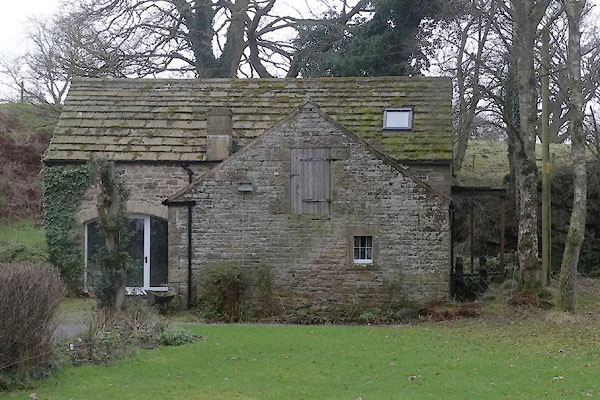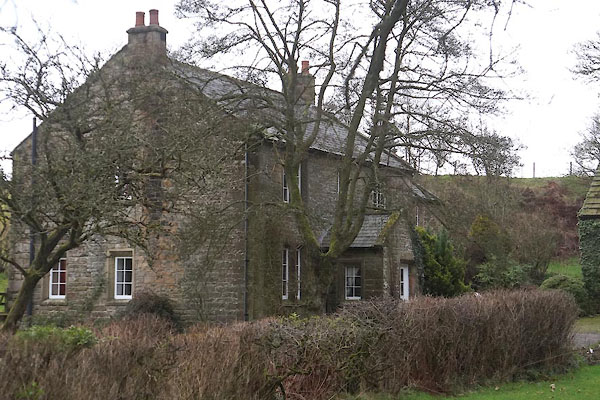





CEM98.jpg (taken 25.1.2016)
placename:- Clockey Mill
"Clockey Mill (Corn)"
placename:- Clockey Mill
courtesy of English Heritage
"CLOCKEY MILL / / WEST HALL / KINGWATER / CARLISLE / CUMBRIA / II / 504631 / NY5831066917"
courtesy of English Heritage
"Water-powered corn mill, early C18 with mid C19 extension."
"MATERIALS: roughly coursed sandstone rubble with dressed sandstone quoins under stone slates, with some asbestos patching. Modern slate roof covering to extension."
"PLAN: L-shaped plan form formed by original rectangular building oriented north-south with an external wheel pit to the south west and a later rectangular extension to the north west."
"EXTERIOR: Main (North West) Elevation has a projecting gabled block, probably a cart shed with store over, to the right and a plain rectangular entrance to the left; this opening with a stone lintel and chamfered door jambs has been widened with the loss of the left jamb and the insertion of steel and concrete lintels. The only other feature on this otherwise plain elevation is a small window opening with a stone lintel in the upper right corner. The cart shed with a pitched roof, has a single ground floor window with a 6-pane casement and a centrally placed first floor loading door with boarded wooden door. There is a cobbled area at the entrance to the cartshed and the mill building. Right gable has small aperture at the apex and the remains of the water wheel spindle and hub retaining the rotted remains of some of the spokes, extending over a stone lined wheel pit. The wheel pit formerly housed an overshot wheel fed from the east by a water chute, discharging via a culverted tailrace to the west; the remains of the metal fixings for the chute remain in situ attached to gable wall, which also bears grooved indentations caused by the rotation of the former water wheel. Left gable has a small ground floor window with stone lintel and sill at the left and a centrally placed window with timber lintel at first floor level; both have 4-pane casements. Rear (South East) Elevation has scattered fenestration including a first floor window with timber lintel bringing light to the milling floor, a small ground floor window with stone lintel and a small blocked opening with stone surround set low down in a central position. To the right the present ground floor window with 6-pane casement frame was formerly another door."
"INTERIOR: divided into three equal bays by an upper cruck roof structure incorporating two trusses with through-purlins and a ridge purlin; joints are largely trenched and lapped. The south bay retains some machinery including the wheel spindle and a pully; the latter sits over a pit, now infilled with rubble, retaining the scant remains of timber framing which probably relates to an earlier configuration of machinery. The south gable wall has numerous holes, formerly housing further machinery. The south bay also has two of the original four wooden supports and a large lateral beam and wooden rail of the first floor mezzanine, which comprised the milling floor and housed the millstones. Set against the west wall of the central bay are the remains of a chimney flue. The central and north bays are open to the roof but were once floored."
"SUBSIDIARY FEATURES: the water management system for the mill included a dam, a pond and a culverted tailrace. A single large and intact millstone is set into the path to the adjacent house."
"HISTORY: Clocky Mill is mentioned in two rentals dated 1704 and 1714, which record the transfer of the mill from the Right Hon. Charles Earl of Carlisle to first George Foroster and then John Routledge, Yeoman. The latter document refers to the `Water Grist Mill' at Clocky with its houses, buildings, dams, wears and ponds. Most of the smaller water mills in Cumbria were established between 1690 and 1730. North Cumbria was historically dominated by cattle farming with very little arable land, which might suggest that the mill was producing animal feed from corn, beans, pulses etc. The First Ordnance Survey map of the area published in 1895 shows that the original rectangular mill building had been extended to the west by this time. This probably occurred in the mid C19 when the present house was constructed. The mill is thought to have continued in use into the early years of the C20 and in its latter years it housed a hydro-electric generator."
"SOURCES:"
"'The Rise of the White Loaf' J Harrison, 2005 (Society for the Protection of Ancient Buildings, Mills Section)"
"M Davies-Shiel Watermills of Cumbria"
"www.cumbria-industries.org.uk/corn.htm"
"J Melling Clockey Mill unpublished report 2008."
"REASONS FOR DESIGNATION DECISION This C18 corn mill is designated in Grade II for the following principal reasons: [bullet] It is a good example of a small C18 rural water mill [bullet] Its vernacular style is well executed with good use made of local materials [bullet] The original plan form is intact and readable [bullet] It retains evidence of original process, which aids understanding of the operation of a small-scale water driven corn mill [bullet] The survival of the crudely constructed and intact upper cruck roof structure is an important feature [bullet] The survival of milling machinery is rare nationally"

CEM99.jpg The house adjoining.
(taken 25.1.2016)

 Lakes Guides menu.
Lakes Guides menu.